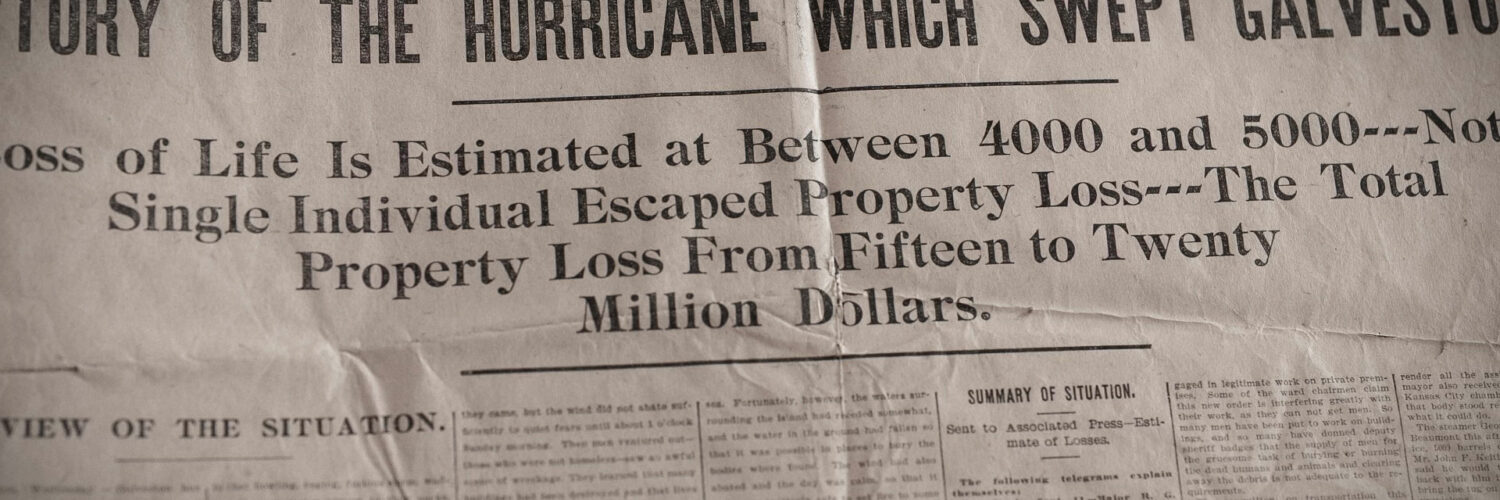WHY WE STILL TALK ABOUT THE GREAT GALVESTON HURRICANE OF 1900
BY ELISABETH CARROLL PARKS, #GALVESTONHISTORY CONTRIBUTOR
Linda has told her grandfather Clarence LaCoume’s story many times. She heard it many times, too, perched on the soft arm of his easy chair in her grandparents’ Galveston home. “My grandfather was 6 years old at the time of the storm. I would listen to him tell these stories from the time I was 3 years old,” she says. “He would stare forward, not looking at me, and he would talk about the things that happened to him. He was reliving it all.”“My grandfather didn’t call it the Great 1900 Storm or any of those designations that we use today,” Linda Macdonald says. “He simply called it The Storm.”
At the turn of the 20th century, Clarence, his parents Bernard and Nora, and his sisters and brothers lived at 2226 Winnie Street, on the second floor of the family’s bakery right across the street from Trinity Episcopal Church.
 On the morning of September 8, 1900, Clarence was playing outside with his brothers. Linda describes the scene: “It was a lot of fun getting sticks to be ships. There was a current to the water, so they raced the sticks down the street. Then, the water came up over the curb. Yes, it was blustery, and yes, there was a little bit of rain––but splashing there in the street was so much fun. He was having a great time.
On the morning of September 8, 1900, Clarence was playing outside with his brothers. Linda describes the scene: “It was a lot of fun getting sticks to be ships. There was a current to the water, so they raced the sticks down the street. Then, the water came up over the curb. Yes, it was blustery, and yes, there was a little bit of rain––but splashing there in the street was so much fun. He was having a great time.
“But then, the flood waters increased. The current increased. The rain increased. By 11 o’clock, the wind was blowing at 30 miles per hour.
“My grandfather didn’t want to admit to his brothers that he was a little frightened. So when his mother called them all in to get ready for lunch, he was relieved––because it wasn’t fun anymore.” All of the LaCoume children headed upstairs.
EXCLUSIVE MEMBER-ONLY CONTENT
 GalvestonHistory+ members have access to exclusive video content associated with this online feature. Log into your member account here, or join today for access to our monthly content, member-only ticketing, and more.
GalvestonHistory+ members have access to exclusive video content associated with this online feature. Log into your member account here, or join today for access to our monthly content, member-only ticketing, and more.
It was about 5 p.m. when the Galveston Weather Bureau’s John D. Blagden took a reading and discovered winds were racing at 84 miles per hour with gusts of 102. Right after that, the wind’s speed seemed to increase. John peered through a window and saw a horse, carried by floodwaters and gusts, speared by a telephone pole. He took to the roof, determined to document the velocity of the wind. But the instrument used to measure the wind’s velocity had been torn off the side of the building.
“That’s why no one really knows the exact strength of the winds in the 1900 Storm,” Linda says.
At 7 p.m., a tidal surge struck the island on the south shore. Linda continues her grandfather’s story: “It hit with such force that buildings and houses along the beachfront were ripped from their foundations and sent like battering rams into other houses.
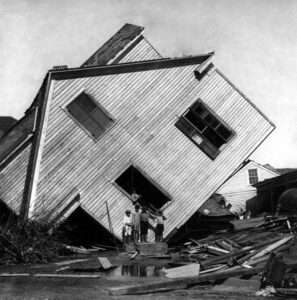 “Houses fell upon houses. Whole blocks of homes fell upon blocks of homes, like dominoes. Inside those houses, there were people. Families, huddled together, were cast from the safety and security of their houses into the dark, tumultuous waters.
“Houses fell upon houses. Whole blocks of homes fell upon blocks of homes, like dominoes. Inside those houses, there were people. Families, huddled together, were cast from the safety and security of their houses into the dark, tumultuous waters.
“My grandfather said the sound was horrible that night. He described the howling of the winds and the screaming of the people and the crying of the houses. I’ll never forget when he said that.
“I very smugly replied, ‘Grandpa, you’re pulling my leg. Houses don’t cry.’
“He said, ‘That night, everyone, everything cried. It sounded like a thousand demons, screaming in the night.’ He said he would hear children calling for their mothers, women screaming for help, and men, begging for mercy from God.
“He heard those sounds in the distance, and then, they would get louder and louder as someone floated by. Then, most often, they would be abruptly cut off. And he knew that someone had died.”
Linda couldn’t imagine her grandfather, so strong and more than 6 feet tall, crying. “I asked him, ‘Did you cry, Grandpa?’
“He said the sounds were so frightening, and the waters were rising. He knew if he were in the bakery downstairs, the water would have been over his head. Then, the house started to rock. His father got up and ran to the pantry. He came back with a hatchet, an ax, and a crate opener. He gave the hatchet to my grandfather’s brother, James. He put James down by the front door and said, ‘Chop through the floor.’
“Then he took my grandfather and put him between the dining room and the parlor, and gave him the crate opener, which had a little hatchet on the end of it. He told my grandfather to cut through the floor.
“Then, my great grandfather Bernard went into the dining room, threw back a chair, kicked back the rug, and sent his ax into the floor. My grandfather said he was just frozen––he couldn’t believe it.
“His father turned to him and said, ‘Chop through the floor!’
“So my grandfather started chopping. He said the harder he chopped, the harder he cried. It wasn’t just that they were going to die, but that they were all going to die insane. He said it was madness. He thought, ‘The water is rising, and we are cutting the floor to get down to it.’
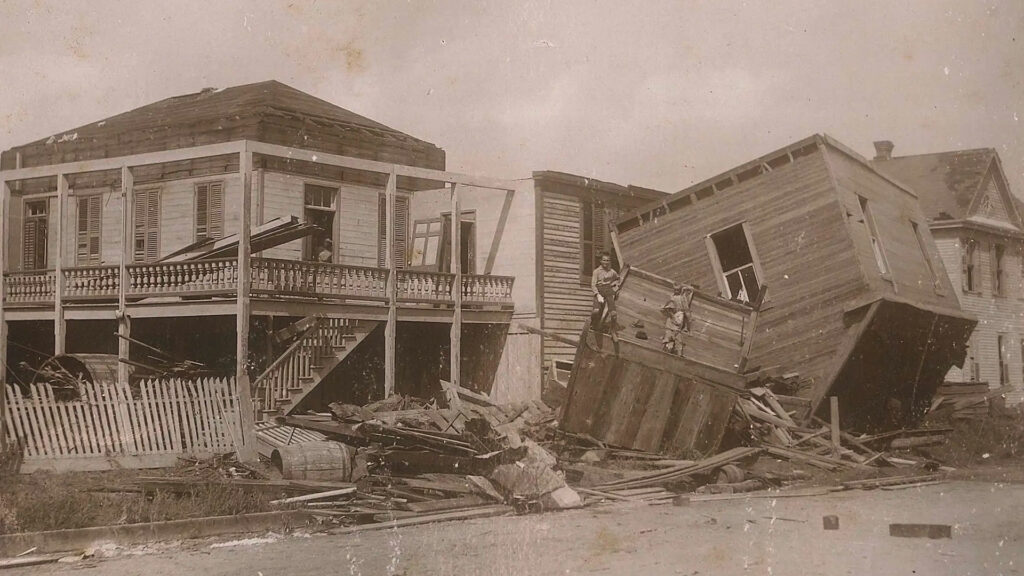 “But of course, what his dad intended was for the water to come up through the holes and to settle the house down to keep it from being knocked off its foundation.”
“But of course, what his dad intended was for the water to come up through the holes and to settle the house down to keep it from being knocked off its foundation.”
Something else saved the LaCoume family. The full force of the tidal surge was absorbed by Trinity Episcopal’s south wall, which collapsed. Water filled the church instead of rushing into the LaCoume’s home.
Across the island, people fought for their lives. Little Lucy Rizzo, who would grow up to marry James LaCoume and become Linda’s great aunt, faced the storm with her parents. “Their house started to shake and sway. Her dad said, ‘This house is not going to stand. We need to get out of here,’” Linda says.
“Some men came by in a boat. They had room for Lucy and her mom, but they didn’t have room for her dad. Lucy didn’t want to be separated from her father. She kept calling, ‘Papa! Papa! No, Papa!’
“Lucy’s mom put her in the boat, put her arm around her waist, and held on to her very tightly. Her father stood on the porch with the wind and the rain beating against him. He kept calling to Lucy, ‘It’s okay. I will be with you soon. I promise I will take you home. I promise you: I will come for you, and I will take you home.’
“For as long as she could, Lucy called, ‘Papa! Papa!’ until finally in the darkness, she couldn’t see him any longer.
“Lucy and her mom were taken to the Jesuit’s residence that was part of St. Mary’s University, next to Sacred Heart Church. Lucy laid on the floor and watched and waited for her father, who never came.”
The hurricane came and went, as hurricanes do.
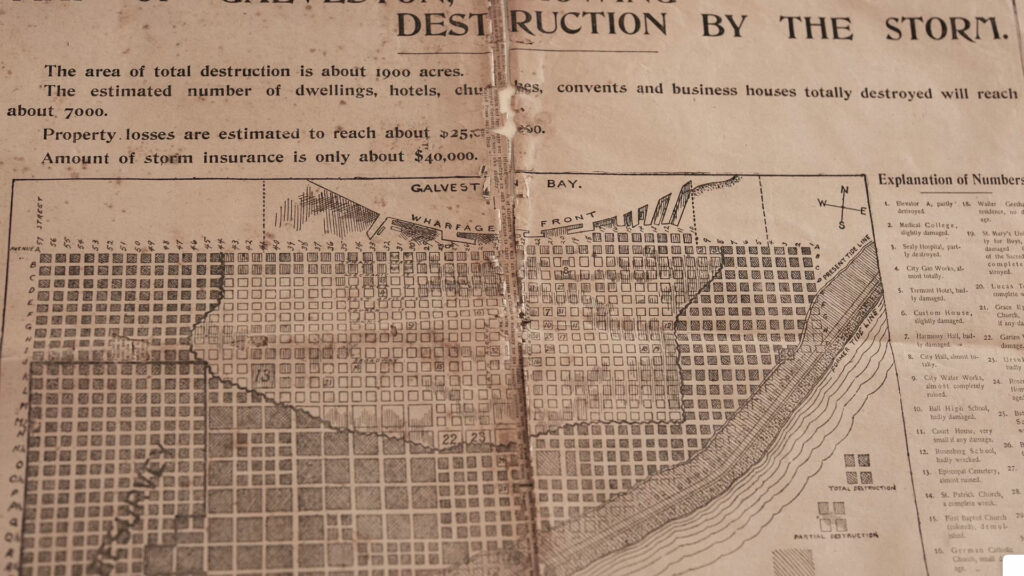 “The winds died down around midnight. A bright, full moon came out,” Linda says. “People came out to see the devastation. Where there used to be blocks and blocks of houses, there was nothing but water.
“The winds died down around midnight. A bright, full moon came out,” Linda says. “People came out to see the devastation. Where there used to be blocks and blocks of houses, there was nothing but water.
“The next morning, my grandfather followed his dad down the stairs into the bakery. The front windows were all broken out, and a slime covered everything. There was glass everywhere.
“The front door was swollen and warped. They pulled it open, and there was a big barrel, unharmed, as though a delivery person had placed it there. They opened the barrel and found it was filled with wine.
“My great grandfather Bernard was from France. He came to Texas when he was 17 in 1875. He was very, very proud of his French heritage. My grandfather told me that his dad looked at him and said, ‘See, son? Don’t ever forget that even in times such as these, the good Lord remembers the needs of a Frenchman.’”
Left without clean drinking water, the LaCoumes relied on the wine, which they shared with neighbors. The bakery’s commercial oven soon came into play, too. “When they were cleaning up one day after the storm, a man in uniform came to the door. He told my great grandfather Bernard that he needed him to make bread. Bernard told him he didn’t have anything to make bread, and the man replied, ‘Now you do,’ and pointed down Winnie Street, where there was a mule train of supplies.
“The bakery made bread around the clock. The boys all helped. Every morning, a wagon came to pick up bread for those in the tent camps and other places that had been set up. If folks worked, they received food.
And that is how my grandfather’s family survived The Storm on bread and wine.”
***
DO WE STILL NEED TO TALK ABOUT THE STORM?
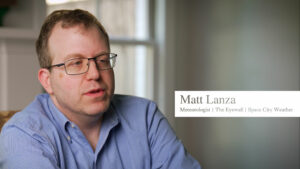 Matt Lanza––Editor of The Eyewall, Managing Editor of Space City Weather, and one of the Gulf Coast’s most trusted meteorologists––thinks so. “If anything, maybe we should be talking about it more,” Matt says. “It serves as a reminder to everybody, particularly in our area, that we get really bad storms––hurricanes, not just floods. It’s important for us to recognize the vulnerability that we have geographically. We’ve come a long way, but you always have to ask the question, have we done enough?”
Matt Lanza––Editor of The Eyewall, Managing Editor of Space City Weather, and one of the Gulf Coast’s most trusted meteorologists––thinks so. “If anything, maybe we should be talking about it more,” Matt says. “It serves as a reminder to everybody, particularly in our area, that we get really bad storms––hurricanes, not just floods. It’s important for us to recognize the vulnerability that we have geographically. We’ve come a long way, but you always have to ask the question, have we done enough?”
In 1900, Isaac Cline––chief meteorologist at the Galveston office of the U.S. Weather Bureau––was not allowed to even use the word “hurricane” in an official warning without consent from D.C. Today, communities count on local expertise that is proactive and independent. Through new site The Eyewall, Matt is applying Space City Weather’s fact-based, conversational reporting to hurricanes and other noteworthy weather events across the Western Hemisphere.
While technological advances such as satellite imagery and better scientific understandings of our atmosphere and how hurricanes behave have improved our ability to be prepared, we have more in common with Galveston Islanders of 1900 than not. “I think a lot of the time, the perception is that the 1900 Storm was tragic, but now it’s distant or so unlike today,” Matt says. “Yes, it’s been 120 years since it happened, but you just have to understand, the same sort of thing is happening now. There are just different things that people don’t fully understand.”
Matt points out that most islanders probably didn’t worry about a devastating hurricane before the 1900 Storm. Then, the city came together in its response, building the seawall and raising the island. “The place that has seen the worst disaster in history in terms of lives lost can be the leader in hardening itself going forward,” Matt says. Today, protective measures such as the Ike Dike require investment and widespread support, and can serve as blueprints for communities elsewhere.
“You had a similar type of storm in 1915 in Galveston, and the outcome was so much better,” Matt says. “As we shift into a climate that is unstable or changing––however you want to refer to it––we just don’t know how different it could be going forward. We have to learn from the past, and it doesn’t always have to be the recent past. There are clues in the distant past that tell us how bad things can be.”
Ultimately, data and timelines are helpful, but it’s people’s stories that resonate most. “We are still living it,” Matt says. “We are vulnerable to it happening again, and while it may be different in some ways, it’s still caused by the same thing––a storm.”
***
Clarence LaCoume lived to be 81 years old. Near the end of his life, he was easily confused. While his wife made lunch on a quiet day in July, he wandered out of their home, and made his way to the Gulf. Worried when they couldn’t find him, his family called the police. The dispatcher knew just where Clarence was.
Linda remembers the scene on the beach well: “My grandmother said, ‘Clarence, just what were you trying to do?’
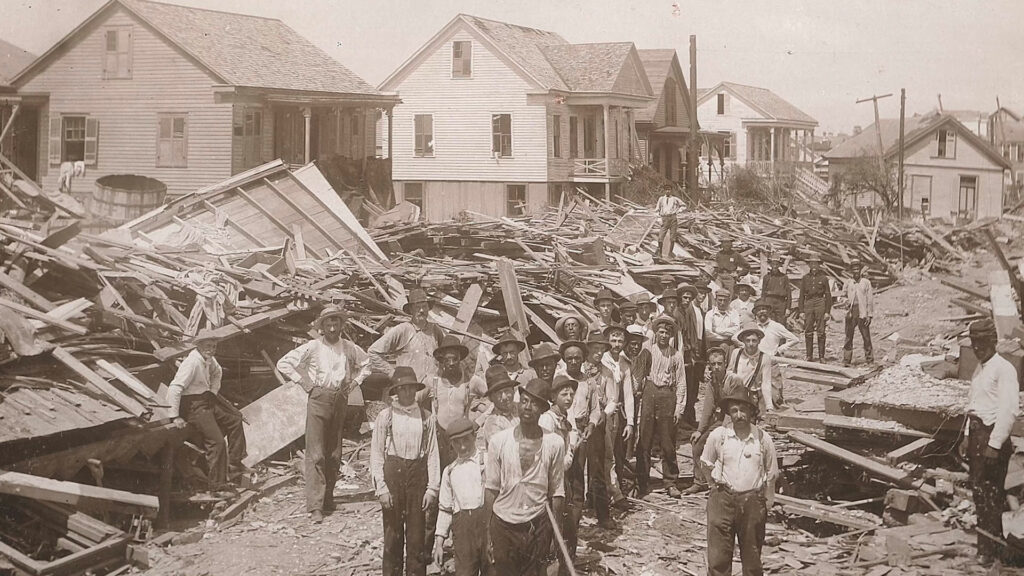 “My grandfather––I’d never seen him so weak. Just frail. He was wet up to his shirt from walking into the water. He had his hat in his hand, and he was holding it with the tips of his fingers.
“My grandfather––I’d never seen him so weak. Just frail. He was wet up to his shirt from walking into the water. He had his hat in his hand, and he was holding it with the tips of his fingers.
“He had his head down, and he looked up at my grandmother and said, ‘I thought the storm had gotten me.’
“Taking his hand, my grandmother said, ‘No, Clarence. You’re safe. We’re going home.’
“She pulled him free of the police officer’s grip, and they started to walk home. The officer who’d been holding on to him chuckled a little and said, ‘What’s the matter, old timer? Did you think there was a storm?’
“It was a beautiful, sunshiny day. My grandmother stopped in her tracks. She went right back and stood in front of the police officer and said, ‘Yes! There was a storm. And you need to know about the death, destruction, and pain that it caused the people of Galveston.’
“All the police officer could say was, ‘Yes, ma’am,’ as she turned and took my grandfather home.”


